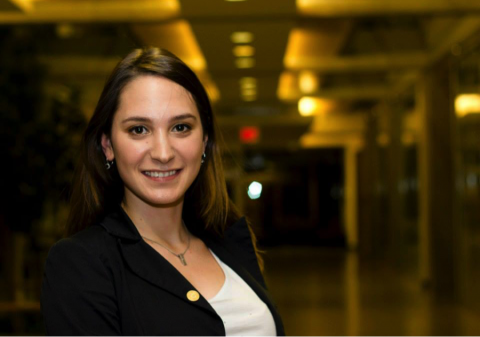
At five years old, Milena Čolović wanted to be a medical doctor. Now, as a master’s student in interdisciplinary oncology at the University of British Columbia (UBC), and as a trainee of the Isotopes for Science and Medicine (IsoSiM) NSERC CREATE program, she’s certainly on her way to that goal.
Her fascination with medicine began with her pediatrician, she says. “You know how the stethoscope is really, really cold? My doctor, she would always heat it up a little bit so that when she would start using it, it would be super pleasant. I remember leaving the doctor’s office and telling my mom, ‘I want to be like her when I grow up’. But that’s like a child’s story.”
Child’s story or not, Milena’s interest in science remained strong throughout her elementary and high-school years. In her home country of Montenegro, she won a national chemistry competition and was awarded the opportunity to attend a science summer camp. “Science camps aren’t common where I come from,” Milena notes. “It was the first time ever that I actually saw science in action and I loved what I saw.”
Milena impressed her teachers from an early age, which resulted in her winning a scholarship from the Ministry of Education of the Republic of Montenegro to study at the prestigious Li Po Chun United World College of Hong Kong.
In 2011, Milena arrived in Canada to begin her undergraduate studies in molecular biology and biochemistry at Simon Fraser University; each year, she earned the W. Ronald Heath International Entrance Scholarship. But it wasn’t long before Milena felt the need for more challenges, so she enrolled in “Introduction to Radiochemistry.” She was the only biochemist in a class full of chemists, physicists and engineers.
Inspiration strikes
This class, which became the first step towards her eventual nuclear science minor, introduced Milena to not just the realm of nuclear medicine, but also one of the professors who would significantly influence her studies: Dr. Corina Andreiou. “She inspired me from the beginning,” Milena says. “We came to TRIUMF for a tour as a field trip and she introduced me to my current PI [principal investigator], TRIUMF’s Associate Laboratory Director for Life Sciences Dr. Paul Schaffer.”
Following her graduation and subsequent acceptance to the interdisciplinary oncology master’s program at UBC, Milena was introduced to the IsoSiM NSERC CREATE program. IsoSiM is a program led jointly by UBC and TRIUMF to provide students with interdisciplinary training and the professional skills they need to succeed in science, industry or the governmental sector. While at first she didn’t think the program would be relevant to her as a non-physicist, the experience is proving to be an enriching one: “Scientists need to communicate their work and the main way we do it, aside from publications, is actually going to conferences and presenting.” Working science professionals are also brought in to shed some light on what students can expect once they leave school, which is very helpful, according to Milena.
The IsoSiM program also provides students with the opportunity to do an internship, either at one of IsoSiM’s industrial partner companies or at an international partner institute in Germany. “I really hope I get to go to Germany,” she confesses. “The work they do at the Werner Siemens Imaging Center is very related to what I’m doing here, and I’m sure that I’d be able to learn a lot.”
New challenges
Currently, Milena’s research is focused on exploiting the various properties of cancer metabolism, specifically increased levels of oxidative stress, to develop novel molecular imaging agents in order to aid in the detection, diagnosis and treatment of cancer.
Cancer cells, she explains, have a faster metabolism, which places them under greater oxidative stress. This means that there is a higher concentration of reactive oxygen species in the cells. To combat this, the cells need to produce antioxidants, such as glutathione - the predominant antioxidant found in cells throughout the body. Glutathione production requires cystine, one of the 20 essential amino acids, to be imported into the cell, which is where Milena's M.Sc. work comes in. "We have developed a cystine mimic that is labeled with a radioactive atom of fluorine, called fluorine-18" she describes. "We have determined that this tracer is very specific to the cystine transport and we are now looking deeper into the behavior of this transporter in response to oxidative stress."
The protein Milena is studying, system xc-, acts like a gate for cystine. System xc- gets upregulated, or increased, in certain cancers, which lets more cystine into the cancer cell. In order to image cancer, a radiolabelled molecule resembling cystine is injected into the patient. The xc- ‘gates’ open for the cystine-like radiolabelled molecules, drawing the molecule into the cancer cell. A PET scanner is then used to detect the cells containing this radiolabelled molecule, effectively identifying the cancer cells in the patient’s body. It’s currently in the pre-clinical stage but Milena hopes that it will eventually be used for diagnostic purposes.
Looking ahead
Milena hasn’t given up on becoming a medical doctor, but her experience with research has opened her up to exploring other paths. “Research is something I’m enjoying very much, and I actually wouldn’t mind extending my master’s degree into a Ph.D. We’ll see.” She hopes to follow the example of her other PI, Dr. François Bénard, and combine her research with clinical work. “What Dr. Bénard does inspires me greatly. It’s very appealing to young researchers like myself with a passion for medicine,” she says. Ideally, she’d like to remain at the forefront of research in medicine, while also spending valuable time with patients and performing actual clinical work. If her numerous past successes are any indicator, whatever path she takes, she’s sure to excel.
For more information about the IsoSiM program, visit the website here.
- Carla Rodrigo, Communications Assistant
